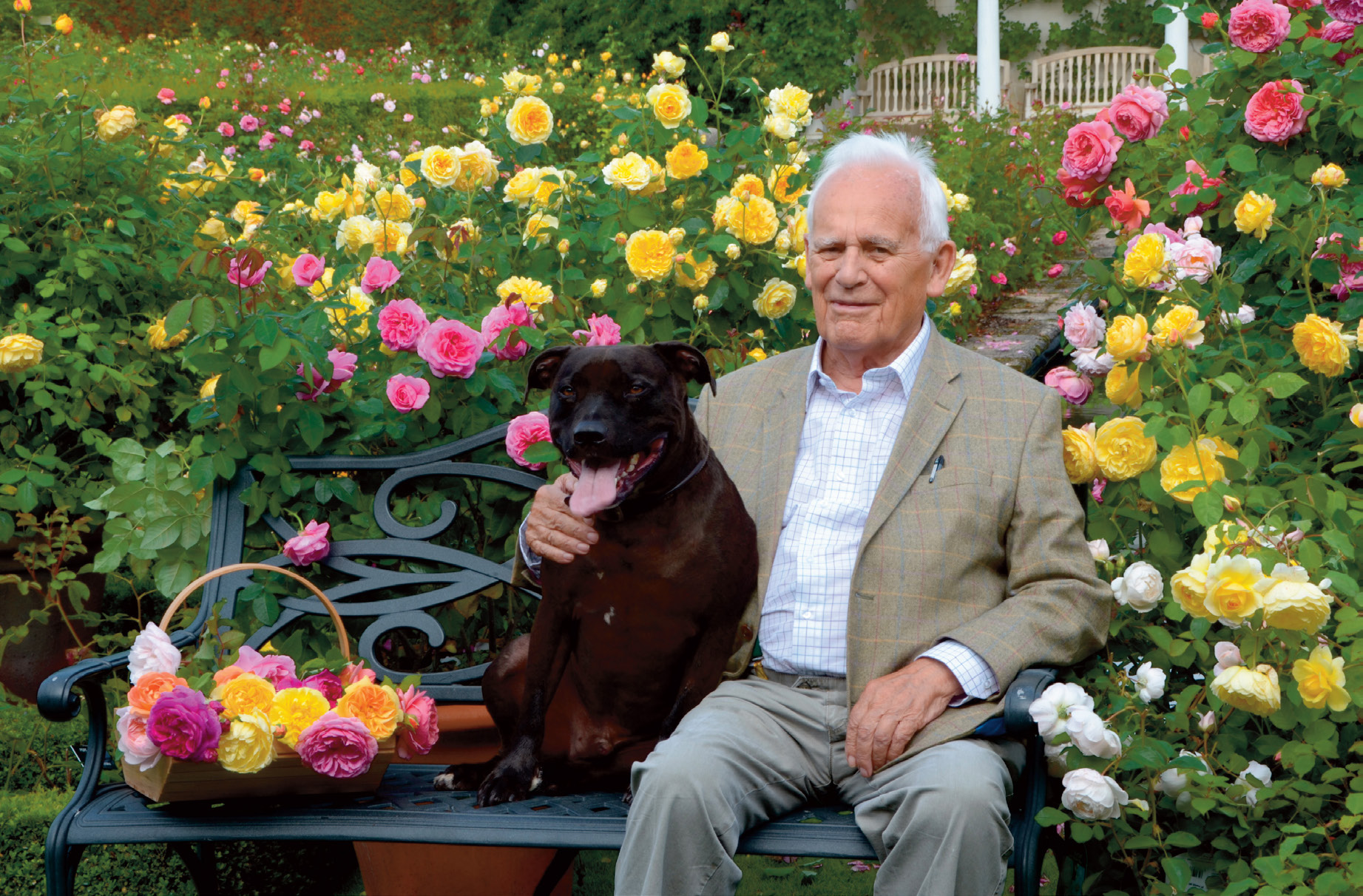
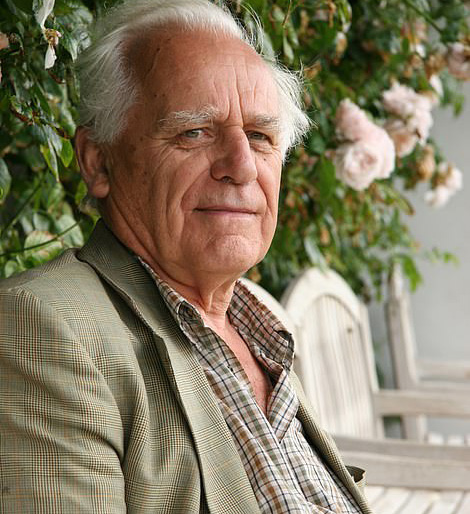
The Creator of “English Roses”
David Austin who passed away peacefully at 93 years at his home in Albrighton in Shropshire on December 18th 2018 often described himself as a self-taught rose breeder. During his 60+ years he introduced into the rose world the concept of old garden rose form but with the added advantages of repeating blooming and delivered in a wider range of colors. This rose magic was a consummated marriage between Old Garden Roses and Modern Hybrids, opening up a new classification which David had wisely christened “English Rosesâ€. Like the treatment received by most entrepreneurs, David’s vision was not a easy victory rewarded by instant acclamation!
On the contrary, the climb to his successes were sluggish
but his perseverance for achievement was persistent and always confident. Rose growers throughout the world owe a great deal of gratitude to David Austin for the gift of “English Roses†and the joy and pleasure his varieties have instilled in countless countries. Indeed it can be said of David that he had a fan club of much greater magnitude and significance than some rock stars of the music world. One day his “English Roses†may be recognized and granted the classification of ‘Hybrid Austinii’?
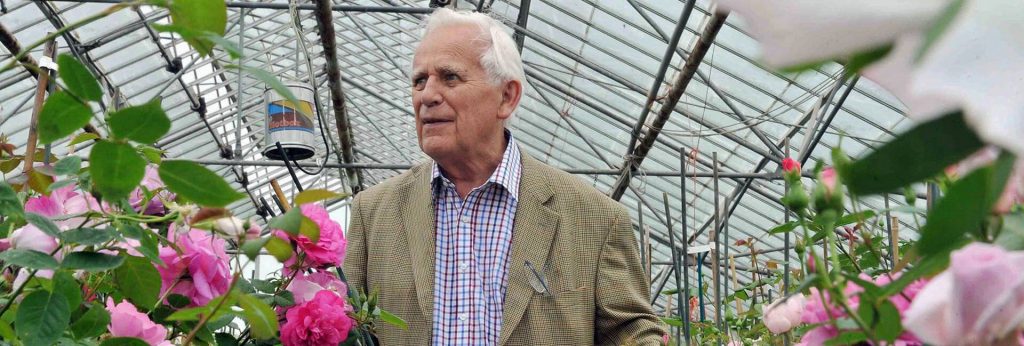
David Charles Henshaw Austin, OBE, VMH, DMH 1926-2018
“The Wisdom to See, The Courage to Actâ€
Rose breeder extraordinaire who created and gave the world the gift of “English Roses†to enjoy, promoted them around the world and yet remained a modest humble man in England during the golden age of roses of the 20th century providing well over 230 hybrids of exquisite beauty and fragrance.
Even ‘Maker of Heavenly Roses’ Fails to of Describe The Marvel of David C.H.Austin
Losing a unique spirit that provided the world of roses with a lasting legacy barely comes close to comprehending the true meaning and measure of the accomplishments of David Austin. Rose breeders have often been referred to as The Makers of Heavenly Roses. And even that description would fail miserably to characterize the outstanding lifetime work of David Austin and his tangible contributions to the evolution of roses. His life is a wonderful story well worth telling for generations to marvel at his achievements.
David’s Teenage Years
David Charles Henshaw Austin was born in 1926 to Charles Austin, a farmer, and his wife, Lilian Austin living in Shropshire, England, where they worked the land that would eventually later became David’s rose nursery. His developing skills in horticulture were the result of a family friend, James Baker, who managed a local nursery and taught him the basic skills. It has been reported that David was initially drawn to lupins.
Roses Not Sheep Breeding Was For Austin
However, at Shrewsbury School where he received his education, David became entranced with copies of the magazine, Gardens Illustrated, which he had discovered in the school library. Little did young David Austin realize that this discovery would point him in the direction of dedicating a lifetime to roses. After leaving school in 1943 David worked the land his family had farmed for 800 years growing barley and potatoes and tending sheep. He soon realized that his calling was dreaming of plant-breeding and not sheep!
Fortuitously his sister as a 21st birthday present gave him a copy of Old Garden Roses by Edward A. Bunyard initiating his inner passion and love for roses as a hobby. Despite his father’s objections, David had chosen a career in flowers with emphasis in roses. But the telltale signs of rose breeding loomed large in his dreams, especially when, in his early twenties he ordered his first few plants and discovering his preference for old garden roses rather the fashionable and popular modern hybrids while recognizing the best attributes of both.
David’s Adult Years
David Austin married Patricia Braithwaite, a sculptor and painter in 1956 who helped him establish the business in 1969. They had two sons – David, who now works in the family business (as does his son, a third generation David) and James (Jim) who is a professor of neutral computing at the University of York.

‘Constance Spry’ the Progenitor of ‘English Roses
And so began a rose journey filled with accomplishments, achievements and honors. The flame that lit the rose candle initiating the journey ahead of David happened in 1962 when a hybrid shrub rose raised by David Austin named ‘Constance Spry’ (a British writer and society floral designer) received rave reviews at the Royal Horticultural Society’s show at New Hall in Westminister. Crossing of a 1845 Hybrid Gallica, ‘Belle Isis’ with a 20th century Floribunda, ‘Dainty Maid’ had given birth to ‘Constance Spry’ appropriately assigned the international registered codename ‘AUSfirst’.
But the continuing journey to ultimate success was fraught with barriers. Many nursery men initially thought such varieties would not sell. Ignoring his detractors David made the marketing decision to sell his varieties by himself converting the kitchen table in his home in Shropshire as distribution central.
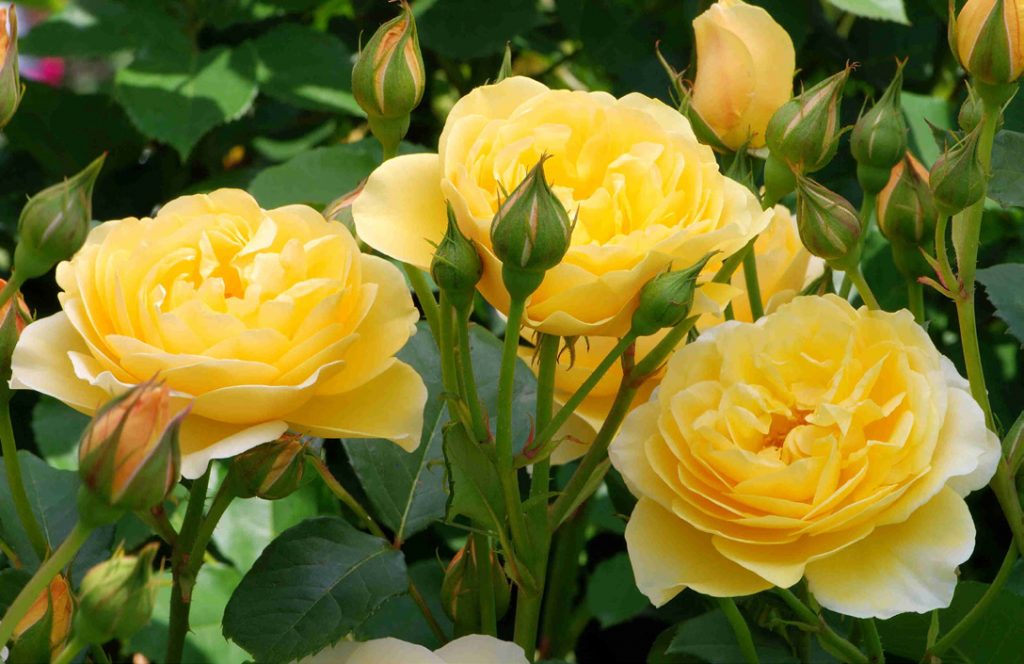
Three Varieties Gained Praise In 1983
Recognition of David’s creativity and genius was slowly picking up, but his fortunes changed significantly in 1983 when he introduced three varieties, including a yellow climbing rose with a fresh tea fragrance, which he named for the well loved horticulturist Graham Thomas. These three varieties were praised by the press and colleagues, and the attention transformed his business. “English Roses†had finally arrived.
The Marriage of Old & Modern Roses Had Begun
This unique marriage of old roses with moderns had began and by the start of the 21st century he had created well over 200 hybrids embraced and loved by rose growers all over the world. David Austin Roses quickly developed into a thriving company which boasted of products sold in almost 50 countries generating revenue of about $23 million in 2011 through direct sales, garden centers and licensees.
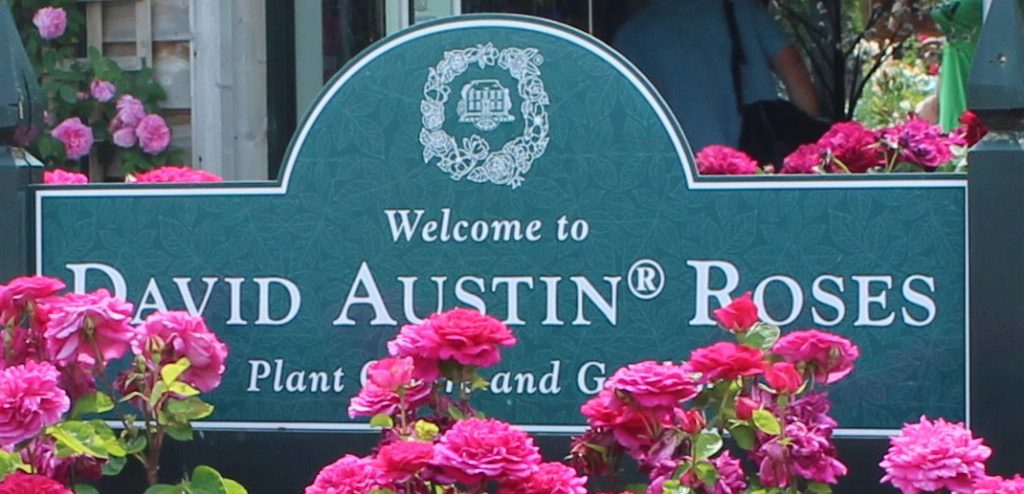
Because of strict plant quarantine laws in the USA imports were controlled through a distribution center in Texas. Anecdotally Steve Jobs, the co-founder of Apple, ordered hundreds of ‘Constance Spry’ to adorn a spectacular 100 meter walkway at Apple’s corporate headquarters in California. In the UK rose enthusiasts visited the nursery or bought Austin roses by mail order.
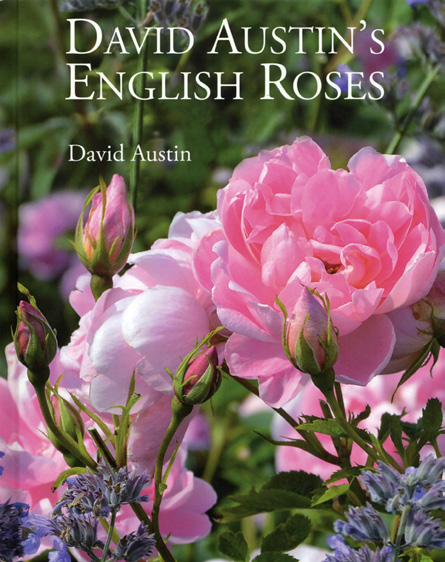
David’s literary talents started in 1988 with the publication of The Heritage of Roses followed five years later by the first edition of The English Roses. Then in 2014 came The Breathing Earth, a collection of his poems drawing on his life experience and love of nature.
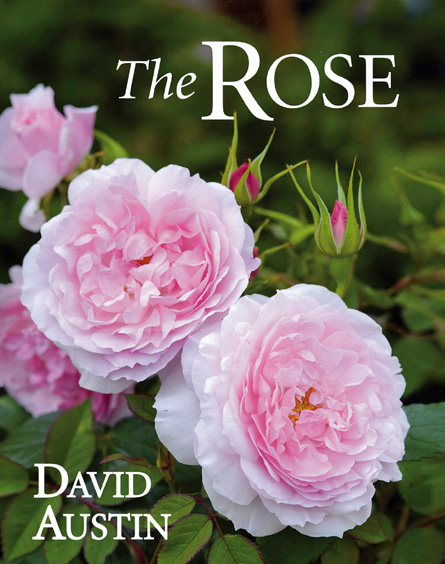
Popularity Worldwide Grew for Austin Roses
In 1990 his eldest son, David J. C. Austin, joined the business developing David Austin Roses into a global company, extending their UK operations into Europe, the USA and Japan. In 1992 a new breeding program was adopted – varieties specially for the cut flower trade. Although the first varieties were released in 2004, yet once again David and his son met with some resistance to this new innovative approach. However, today the cut roses have become very desirable and special as personal gifts, to adorn wedding events, and have featured prominently in celebrations such as the most prestigious Royal Weddings. Varieties most often mentioned as especially appealing as cutflowers are: ‘Abraham Darby’, ‘Eglantyne’, ‘Fisherman’s Friend’, ‘Jude the Obscure’, and ‘Sophy’ s Rose’.
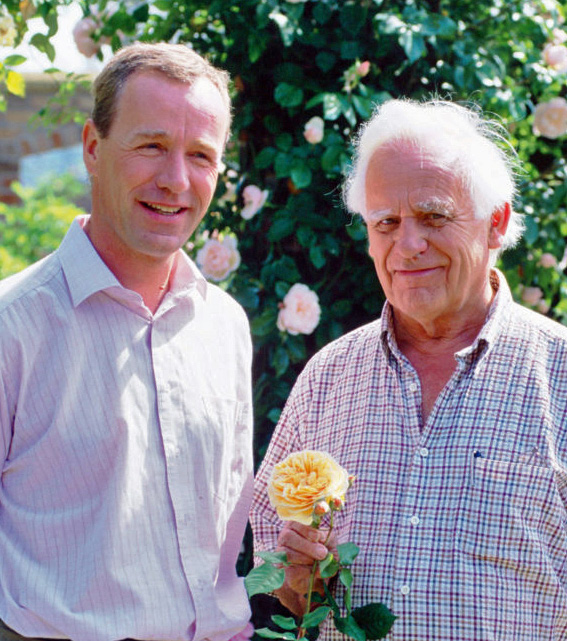
Still Remains A Family Business
While David Austin Roses has flourished with great success, it still remains a family business. For instance, Richard Austin, David Senior’s grandson, and son of David Junior, joined the company in 2010 continuing his father and grandfather’s passion. The David Austin family affectionately referred to David Senior simply as ‘Mr A’.
Like most rose breeders of his time David admitted that the quest for the perfect rose was a never ending task, and he always insisted that there was much work yet to be done. When asked a few years ago if he was planning to retire, David replied “No, I’m just as excited about breeding roses now as I was when I started doing it as a hobby as a 15-year-old. I think my latest roses are some of the best I’ve ever produced, but they’re not perfect. I want to breed a really good crimson rose and continue improving the disease resistance of our roses. That’s what drives me on – my love of roses, and knowing there are still better ones to come.â€
Some Famous Quotes  by David C.H. Austin
“A rose without a fragrance was only half a rose.â€
“This idea of crossing the old roses with the modern seemed to me to be such a good thing to doâ€.
“I was never that influenced by what other people said or thought. I’m sightly dyslexic, and I think I make connections that other people don’t.â€
“I was still an amateur with very little thought of becoming a professional nurserymenâ€
“There are so many leads – many of them blind alleys. You need great patience and the skills to recognize what is really outstanding. Every time I make a cross, I think there is always something more beautiful to come.â€
“There is nothing more exciting than having 350,000 seedlings growing that no one has ever seen before.â€
“Every day, I marvel at my good fortune to have been able to make a life out of breeding roses. My greatest satisfaction is to see the pleasure my roses give to gardeners and rose lovers around the worldâ€.
“Most of these won’t ever be released†he said in 2016 pointÂing to row upon row of colorful roses from which he would eventually select only half a dozen or so new varieties. “The rest get dug up and composted ….. There’s no point in being sentimentalâ€
“…. if I had to chose just one, I think pink ‘Olivia Rose Austin’ named after my granddaughter has to be one of the best I’ve ever bred.
Some Famous Quotes Michael Marriott, his longtime colleague and company rosarian
“He had gone around to other rose nurseries [in England] and tried to get them to grow them for him. They all rejected him out of hand.â€
“He used to say that the easiest way to kill a rose was to give it a bad name.â€
“He lived and breathed them all the time. He had little time for other things and was not a particularly social man. He was quite shy and very happy to dedicate his life to roses.
Recognition of His Accomplishments
“He was loath to be drawn on favorites, but admitted to havÂing a weakness for the ‘Claire Austin’ variety named after my daughter and is an outstanding white rose.†“But if I had to chose just one, I think pink ‘Olivia Rose Austin’ named after my granddaughter has to be one of the best I’ve ever bred.â€Â ~ David C.H. Austin
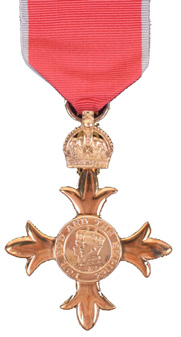
Order of the Bristish Empire
The Order of the British Empire, or OBE, is an award granted by the government of the United Kingdom and awarded, typically in person, by the current king or queen of that nation to individuals who have performed excellent work in arts, sciences, public services and charitable efforts.
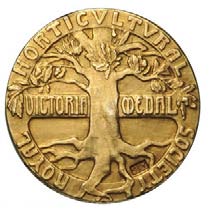
RHS Victoria Medal of Honor
The Victoria Medal of Honour (VMH) may be awarded to British horticulturists deserving of special honour by the Society and is awarded for life. Only 63 medals may be held at any one time, in recognition of Queen Victoria’s reign.
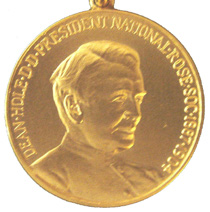
RNRS Dean Hole Medal
The Dean Hole Medal is the highest award that the Royal National Rose Society makes and is awarded “For Outstanding Service to the Society and the World of Rosesâ€.
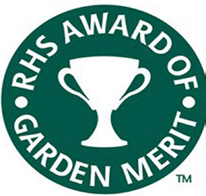
RHS Award of Garden Merit
To qualify a plant must be available horticulturally, be of outstanding excellence for garden decoration or use, be of good constitution, not require highly specialist growing conditions or care, not be particularly susceptible to any pest or disease, and not be subject to an reversion.
‘Darcey Bussell’
‘Molineux’
‘Kew Gardens’
‘Scarborough Fair’
‘Skylark’
‘Strawberry Hill’
‘A Shropshire Lad’
‘Charlotte’
‘The Generous Gardener’
‘Grace’
‘Teasing Georgia’
‘Gertrude Jekyll’
‘Golden Celebration’
‘Lady Emma Hamilton’
‘The Mayflower’
‘Munstead Wood’
‘Graham Thomas’
‘Lady of Shalott’
‘Molineux’
.Mortimer Sackler’
‘The Pilgrim’
‘Port Sunlight’
‘Princess Anne’
‘Wildeve’
24 Gold Medals
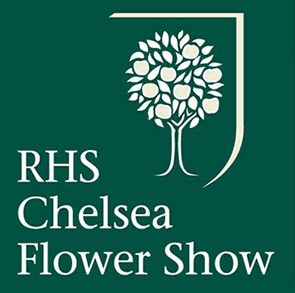
World’s Favorite Rose 2009
World’s Favorite Rose 2009 ‘Graham Thomas’
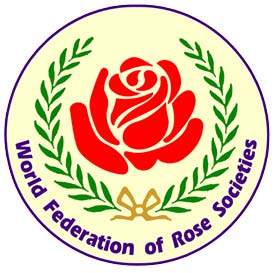
Award of Garden Excellence


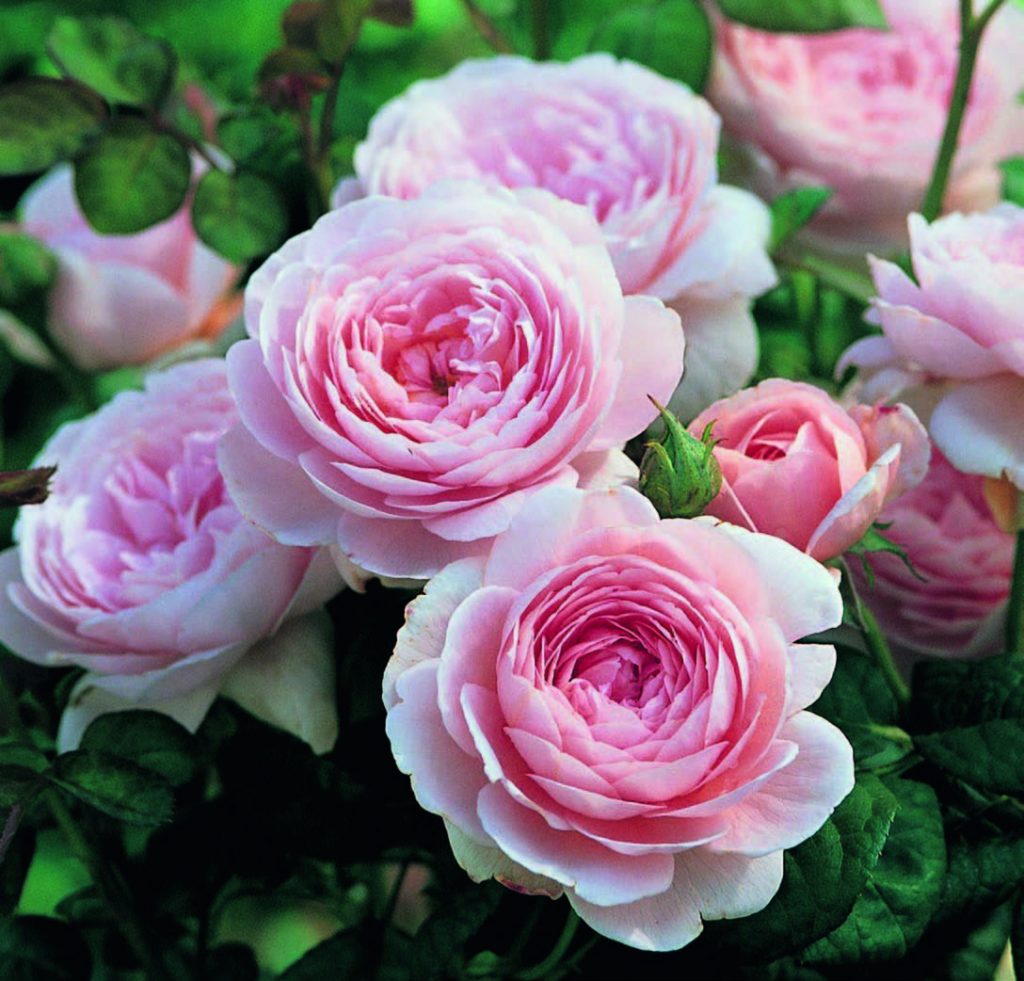
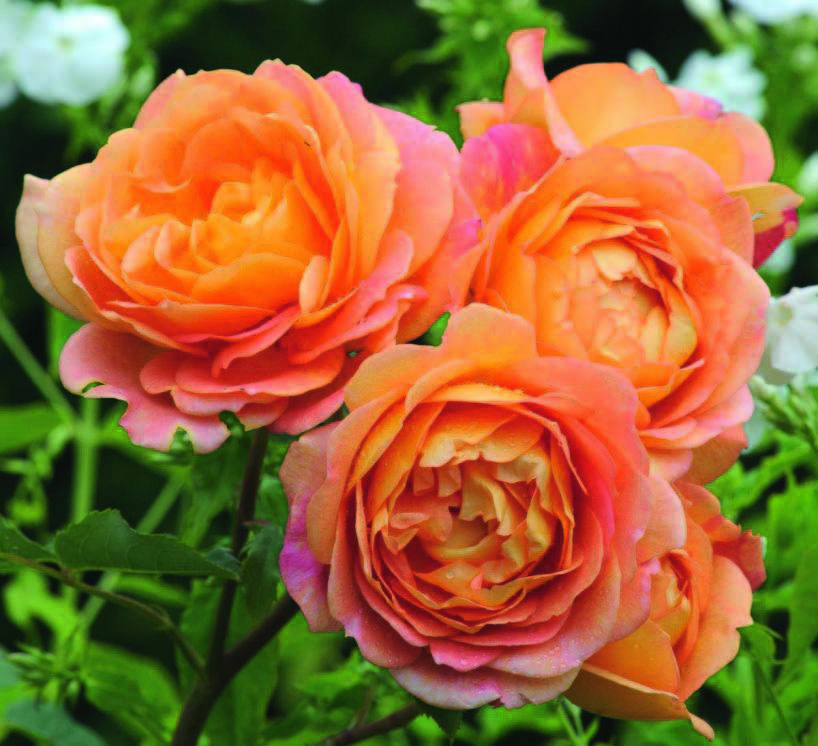
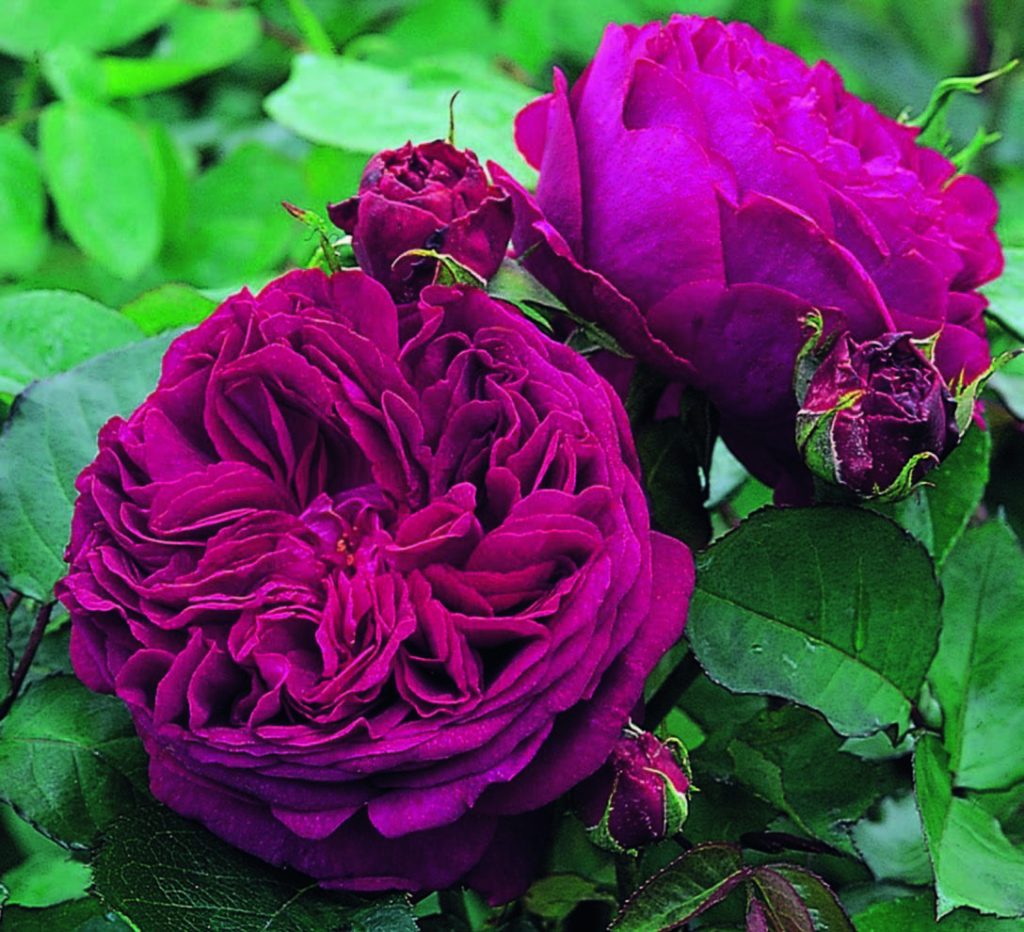
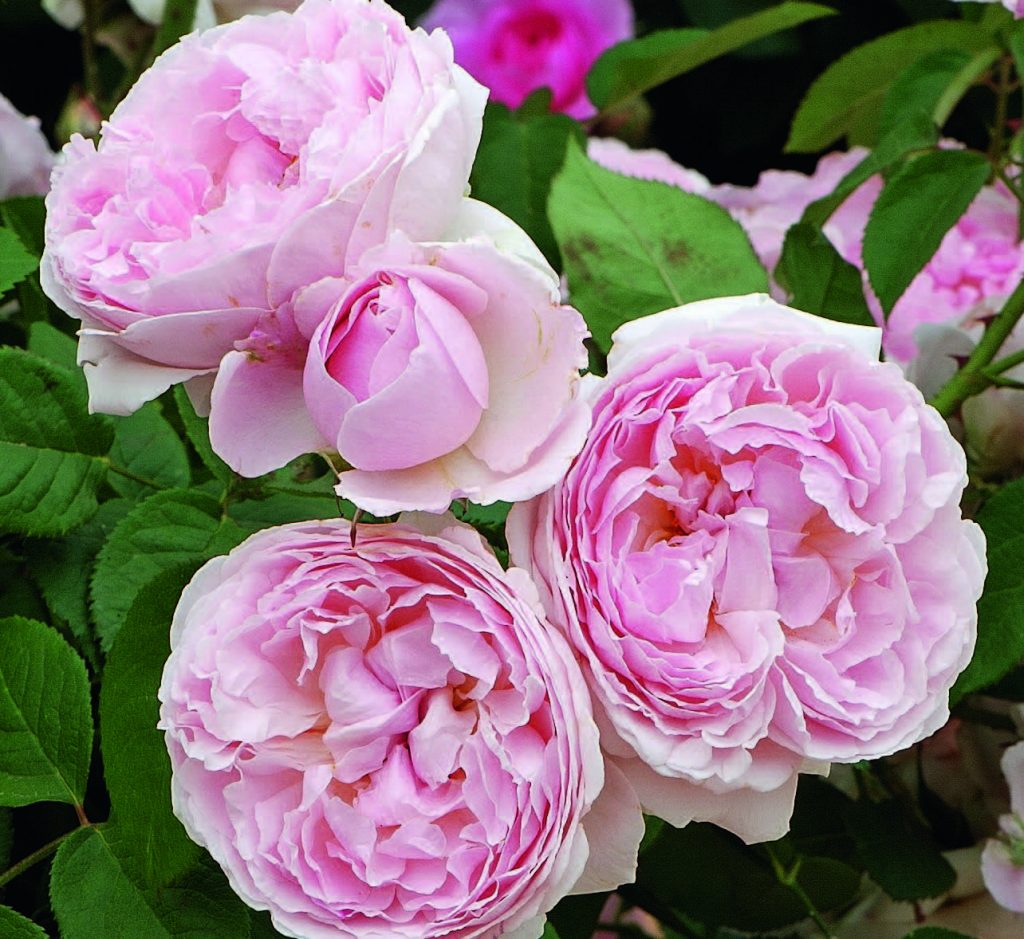
Technical Significance of English Roses
David Austin settled on the name for his creations by evoking the fact that the Scots had their own roses and so did the French, so why not the English. This brilliant marketing plan helped capitulated his varieties into prominence.
The progenitor of “English Roses†was born in 1961 from a cross of a 1845 Hybrid Gallica, ‘Belle Isis’ with a 20th century Floribunda, ‘Dainty Maid’. That rose was named ‘Constance Spry’ appropriately assigned the international registered codename ‘AUSfirst’. The significance of that cross between what was a non recurrent flowering Gallica as seed parent and a repeat flowering modern Floribunda as pollen parent hopefully would combine the delicate charm, form and bouquet of an old garden rose with the habit and repeat flowering inherited from a modern rose – at that time an unconventional approach to rose breeding!
But the cross was not completely successful in ensuring repeat flowering for ‘Constance Spry’ was at best only summer flowering. Then in 1967 Austin introduced another summer flowering shrub ‘Chianti’ hybridized using as seed parent the 1948 prize winning Floribunda ‘Dusky Maiden’ with the pollen parent the Hybrid Gallica ‘Tuscany’. And again in 1968 Austin introduced another cross between an old garden rose and a modern repeat flowering variety, ‘Shropshire Lass’ born from ‘Madame Butterfly’, a classic 1918 early Hybrid Tea with ‘Madame Legras de St Germain’, an 1846 Alba. Alas they too were only summer flowering.
With this triumvirate of potential genetic material, Austin finally developed the first varieties that were indeed repeat flowering but markedly inherited the charm, elegance, fragrance and form of garden roses. They were the ‘Wife of Bath’ and ‘Canterbury’. Having been forced to read “The Canterbury Tales†by Chaucer in school, most scholars can only recollect that the Wife of Bath was a most unattractive lady with perhaps a front tooth missing or at least a very large space between her front teeth. Hardly an appropriate name for such a lovely rose! In producing this rose Austin has used an early 1890 Hybrid Tea, ‘Madame Caroline Testout’ as seed parent with pollen derived from the cross of ‘Ma Perkins’ with ‘Constance Spry’. Similarly ‘Canterbury’ with recurrent flowering capability and old garden elegance was the result of the seed parentage of a cross between ‘Monique’ (a 1949 Hybrid Tea) and ‘Constance Spry’.
At this juncture David coined the term “English Roses†to symbolize a new breed of roses, not a new classification for they were shrubs under the existing international registration scheme. By the time ‘Graham Thomas’ and ‘Mary Rose’ were introduced at the Chelsea Flower Show in 1983, “English Roses†had gained acceptance and popularity throughout the world. Since that time David Austin has introduced over 200 varieties. This marketing strategy was nothing less than a brilliant idea which captured the attention of the rose
Properties of an “English Roseâ€
1. A Beautiful Flower
The form and brilliance of the blooms is cloned directly from Old Garden Roses retaining their best qualities. They may be cupped, quartered, or rosette shaped and come in an attractive array of delightful colors, mostly pastels although there are a few stunning dark reds, with many small petals that the light tends to bounce off and be forever captured within the flower itself.
2. Pleasing Growth Habit
Plants have a natural shrub-like growth that blends into the overall garden display without overpowering other companion plants. On the contrary, they create that perfect English garden look oozing with tranquility and passive ambiance.
3. Attractive Foliage
Behind every great flower is great foliage and “English Roses†are no exception to that concept.
4. Wonderful Array of Fragrances
Outwardly “English Roses†are first noticed for their elegant and delicate charm. But the smell quickly seduces the gardener to their inner intense power. The fragrance range stretches from Tea Rose fragrance to Musk to Myrrh and to many different fruit flavors adding to their overall popularity and acceptance.
5. As Cut Flowers
Every gardener has a desire to bring the fruits of their labors into the home rather than allow the weather to cut short the life of their roses. “English Roses†amplify that urge while providing even the amateur flower arranger a golden opportunity to create beauty within the home. This aspect of “English Roses†as cut flowers has spawned a new sales activity within David Austin Roses, that of providing the florist trade and the public the ability to purchase certain varieties tested to be long lasting with overnight service. This activity has caused a sensation as the cut roses have become very desirable and special as personal gifts, to adorn wedding events, and have featured prominently in celebrations such as the most prestigious Royal Weddings.
Postscript from the Author
The sad part of this great story is that while David Austin has been recognized with various honors for his work, “English Roses†still remain classified as Shrubs by the International Registrar for Roses. For such a wonderful and widely accepted groups of evolutionary roses the stigma of the word “Shrub†does not do justice to the superlative work of David Austin. Efforts were made at the recent World Rose Convention in Copenhagen in July 2018 to recommend a new classification recognizing David Austin’s work as Hybrid Austinii based on the historical precedence of the existing group known as Hybrid kordesii. After all the classification scheme currently adopted is a mixture of both botanical names and popular commercial selling names. The proposal failed to be adopted and so prevented a formal recommendation to the international registrar, the American Rose Society. Perhaps some day in the not too distant future, the rose world will finally recognized the true significance of this evolutionary development in the history of the rose. But for the moment we must be content to call them Shrubs but can constantly remind the world they are ‘English Roses’.
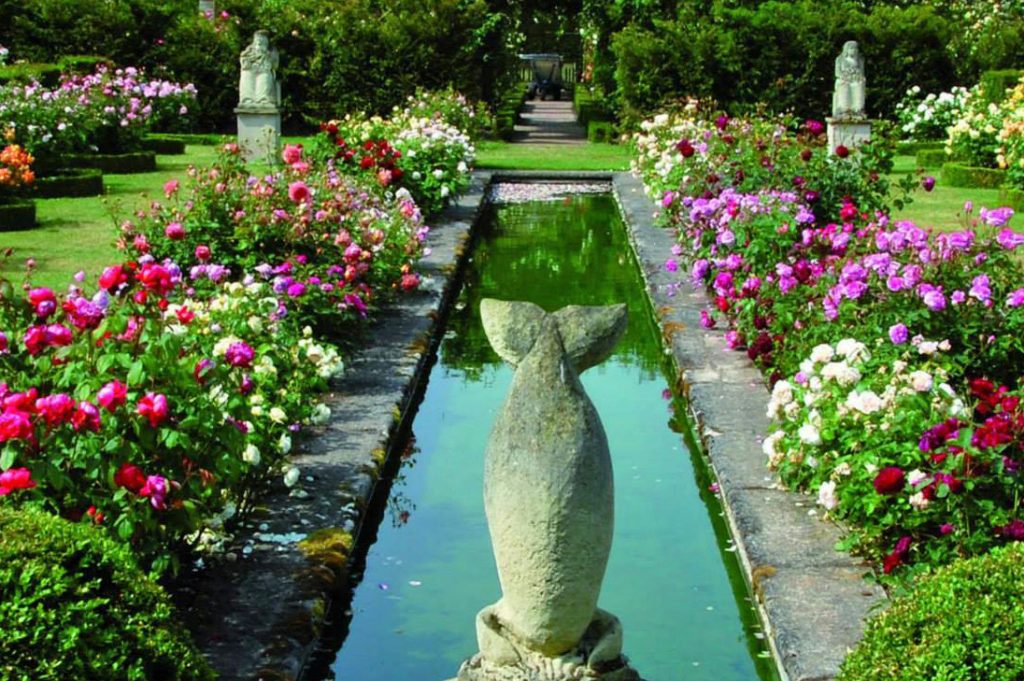
The David Austin Rose Garden at Albrighton, England
The garden started life in 1969 as stock beds for sourcing propagation material but visitors wanting to see a particular rose in flower were shown these roses and the garden gradually grew with the size of the nursery. Initially it was just the Long Garden, with a wide of different varieties – David Austin’s English Roses, Old Roses, Modern Shrub Roses. Species and many climbers and ramblers trained up the pillars and along the wooden beams connecting them.
Next came the Victorian Garden with beds in concentric circles filled with English Roses, repeat flowering Old Roses and climbing roses trained over arches. The Lion Garden has had a number of different guises over the years and is currently a mix of English Roses, Old Garden Roses and perennials with the surrounding walls covered with Climbers. The magnificent stone lion carved by David Austin’s late wife Pat Austin lives at the far end.
The Renaissance Garden used to be the site of the original breeding greenhouses over 30 years ago. New ones were built on the other side of the hedge so this area is purely for David Austin’s English Roses. There is a central canal with a very distinctive crenulated double border on each side. The roses here are pruned quite hard and so stay quite short as opposed to the much more informal beds towards the outside with curved paths and lightly pruned roses.
Right at the top of the garden is an area dedicated to Species roses and their near hybrids underplanted with early flowering daffodils and narcissi. The final garden is separate from the main area; it is an acre paddock of true Species roses, the aim being to plant as many as possible of the 160 or so thought to exist. So far there are over 100 and very splendid they look in the summer with the flowers and in the autumn with the hips.
The main garden covers 1.5 acres and contains about 5,500 roses and several hundred perennials. The first flowers are seen in late April or early May with the early species like R. sericea pteracantha, R. hugonis and the Banksias. It is at its truly magnificent best usually from mid-June for about 6 weeks and then again in September into October and even November.
Naming Logic to Austin VarietiesÂ
With an appreciation of literature and history, David Austin gave such memorable names to his roses as ‘Charles Darwin’ (with yellow cupped blooms), ‘James Galway’ (a climber with dense pink rosettes), ‘Dame Judi Dench’ (orange blooms with ruffled petals) and ‘Roald Dahl’ (whose orange-red buds open up to peach rosettes).
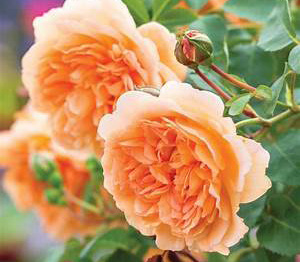
Some varieties were named after people whom Austin admired including ‘Mary Webb’, ‘Benjamin Britten’, ‘Edward Elgar’, ‘Charles Rennie Mackintosh’, and ‘Darcey Russell’, while others had a sense of mischief such as ‘Fisherman’s Friend’, ‘Teasing Georgia’, and ‘Queen Nefertiti’.
His early varieties, which he cleverly christened “English Rosesâ€, often had Chaucerian names such as “The Friar’, ‘The Aquire’, ‘The Prioress’ and ‘The Canterbury’. Yet it was not until 1983, when he introduced ‘Graham Thomas’, a bushy rose with cup-shaped, rich yellow scented blooms, and ‘Mary Rose’, a delicious pink with a classic old-rose fragrance that they really made their mark, taking roses out of the rose garden and into the mixed border where they have since become signature plants in innumerable herbaceous planting schemes
David Austin had an early propensity to name many varieties after characters from The Canterbury Tales such as ‘The Friar’, ‘The Prioress’, ‘The Yeoman’, ‘Canterbury and ‘The Wife of Bath’, his family members and historical icons. Shakespearean characters were represented by ‘Prospero’, ‘Cressida’, ‘Wise Portia’. From Thomas Hardy novels the varieties were ‘Tess of the d’Urbervilles’, ‘Mayor of Casterbridge’, ‘Jude the Obscure’.
Commissions from various businesses and charities: ‘Evelyn’, ‘Financial Times Centenary’, ‘Radio Times’. David also also named them after friends, relatives, and famous English horticultural figures: ‘Geoff Hamilton’, ‘Charles Austin’, ‘Lillian Austin’, ‘Pat Austin’, ‘Graham Thomas’, & ‘Gertrude Jekyll’.
The choice of ‘Robert Burns’, the Scottish poet, was pleasing especially coming from an Englishman! Other European hybridizers were somewhat slow to recognize the evolution of roses created by David Austin, but soon quickly realized their sales potential and emulated his work and developed their own versions of David’s pioneer work. They choose such generic groups names as “Renaissanceâ€, “Romanticasâ€, ‘Generosas’, and ‘Country Roses’.
Memories of David C. H. Austin


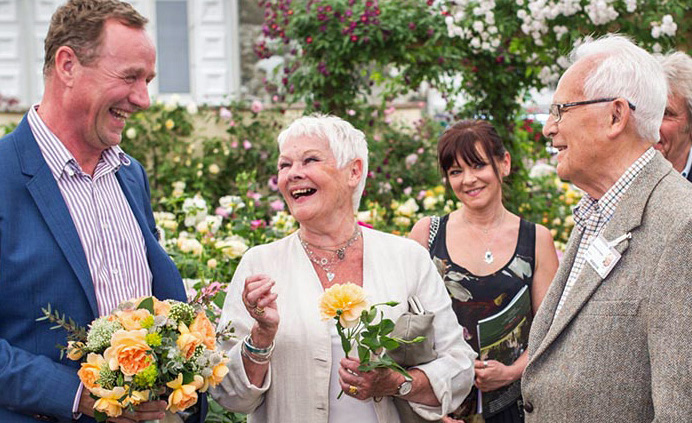

Credit: The author gratefully acknowledges the assistance of David Austin Roses for providing access and use of certain images
Awesome!
I really appreciate this article on David Austin. In an age where we want everything instant and easy we are reminded that the better things in life are a life long pursuits and worth the patience. It’s also a great testament to understand that what we do ultimately is not for our own fulfillment but for the fulfillment of others. When we find that we find true identity. Those truths very much exemplified in Mr. Austins work and the continuing work of his family.
Lucas,
Thank-you for your wonderful comment. It also struck me how hard and how long Mr. Austin Sr. worked toward his goal. He was not an overnight success. He made many attempts that were less than what many might think were highly successful. And who knows if the Apple CEO had not order so many of his roses perhaps he might not have ever known the fame his company knows today, but we know this Lucas he would have still been running David Austin Roses.
Hope you are doing great at your newest endeavor.
Great to hear from you and please stay in touch.
Your friend,
Susan Fox